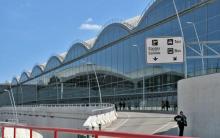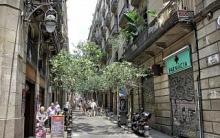The history of the Russian flag is more than three hundred years old. It began in 1668, when, by order of the Grand Duke Alexei Mikhailovich (father of Peter I), the tricolor was raised above the first Russian frigate "Eagle", made by Dutch craftsmen. The ship's crew also consisted of the Dutch. However, reliable information about appearance the flag raised over the frigate has not survived. It is only known that it consisted of three colors: white, blue and red. 
The flag, in the form in which we know it well, was first raised in 1693, by order of Peter the Great, over the 12-gun yacht "Saint Peter" sailing along the White Sea as part of a squadron of warships built in Arkhangelsk. The flag was slightly different from the currently used one - a golden two-headed eagle was depicted in the center of the tricolor. In addition, this flag was not a symbol of the entire state, but "the flag of the Tsar of Moscow." There are many versions explaining the choice of colors on the flag, but the most probable is Peter's blind admiration for everything Dutch (the color of the Dutch flag is red-white-blue).
Starting from 1705, by decree of Tsar Peter (he became emperor only in 1721), the tricolor banner became the official symbol of the Russian merchant fleet. The white-blue-red cloth began to be perceived by foreigners as a symbol of Russia. 
However, in reality, until the end of the 19th century, the country did not officially have a state flag. Such appeared in 1858, when the black-yellow-white banner was approved as the state flag by Alexander II. It was in these colors that the streets were decorated on holidays. But already in 1883, on the eve of the coronation of Alexander III, in accordance with the Highest command, only the white-blue-red flag was supposed to be used to decorate the streets on solemn occasions.
In 1896, before the coronation of Nicholas II, the Special National Conference by its decision confirmed the status of the national flag for the white-blue-red cloth. And yet the debate about which flag is considered national did not subside. From time to time, both white-blue-red flags and black-yellow-white banners were hung out at festive events.
The Day of the State Flag of the Russian Federation has been an official public holiday since 1994. Celebrated on 22 August. It is not a day off.
An end to the confusion was put by the Bolsheviks, who, by their 1918 decree, introduced a new symbol of the new country - the red banner, which, with minor changes, existed for more than 70 years.
One of the main symbols of Russian statehood is the flag, which is a canvas of three colors: white, blue and red. Nowadays, not a single state holiday is complete without this symbol: it is used to decorate residential buildings and state institutions, the flag is solemnly carried at demonstrations and unfurled at rallies. The history of this symbol is as ambiguous and full of events as the history of Russia itself, and it is not for nothing that its colors personify everything that is most important for Russians.
Russian tricolor: from pre-Petrine times to the present day
The emergence of the Russian flag in a form close to the modern one is associated with the reforms of Peter the Great. In pre-Petrine times, banners were used mainly in military campaigns and were canvases embroidered with gold and silver, with church symbols depicted on them, paintings from Scripture, long titles of the sovereign or nobles commanding the army.
During the reign of Tsar Alexei Mikhailovich (second half of the 17th century), the number of banners with non-church subjects, such as the coat of arms, increased. An important starting point in the history of the emergence of the three-lane flag was the construction in 1667 under the leadership of the Dutchman D. Butler of the ship called "Eagle". This vessel was designed to protect Persian merchants during their trade expeditions across the Caspian and Volga. During the construction, Butler declared the need for fabrics for ship banners of those colors that the king would indicate. At the same time, Butler noted in his petition that it is customary to use those colors that are considered state.

The Dutchman's request was satisfied: he was sent in the required quantity "wormy, white, azure" kindyak and taffeta (fabrics popular in old Russia). These flags, like the ship itself, did not last long, they were burned in Astrakhan by the Razin Cossacks, but knowledge about them survived and led to the further use of these colors by Peter the Great.
Speaking about the era of Peter and his reforms, one cannot fail to mention his passion for navigation, shipbuilding and military affairs in general. And since in the past flags and banners were, first of all, a military and nautical attribute, they quickly came to Peter's field of vision.
In the early years, the king used his father's banners, or created new ones, similar to the old ones. But the desire for everything western influenced the creation of banners. When in 1963 Peter, being in Arkhangelsk, first appeared at the sea, he noticed the flags of foreign ships that were at that time in the port. German, Dutch, English banners differed from those that were in use in Russia: they were bright and did not contain any images and titles.
On further visits of the tsar to the sea, he sailed under the tricolor flag of the colors familiar to us, while the coat of arms was depicted on the blue field. This flag has survived, it is in the Central Naval Museum and is the oldest surviving Russian tricolor.

It is interesting that the tsar was personally engaged in the creation of new banners: he was especially interested in flags for ships, he made more than 30 of them. In all his projects, attempts were made to combine the St. Andrew's cross and multi-colored stripes. Ultimately, the tsar's decree of January 20, 1705 proclaimed that a three-lane white-blue-red canvas should be raised on merchant and other civilian ships, and on military ships from 1707 the flag of St. Andrew the First-Called became permanent. The analogue of the national flag in those days was a golden cloth with a black two-headed eagle. The eagle's heads were crowned with three crowns, and in the corners were placed maps of the four seas in which Russian ships cruised. The same colors (black and yellow) were preserved in the ceremony after the death of the first Russian emperor, and were declared state by Empress Anna Ioannovna.
In 1858, Alexander II carried out a reform in the treatment of state symbols in order to consolidate the monarchy. Among other transformations, the Tsar-Liberator established that all banners, flags and other attributes required for celebrations must be made in state colors, which are arranged in a specific order: a black stripe on top, a yellow (golden) stripe in the middle, and a white one below ( or silver).

At the same time, the use of the blue and white St. Andrew's banner, and the tricolor familiar to us on merchant ships, was not stopped. V.I.Dal expressed his opinion on this issue, who believed that too much diversity leads to confusion, and citizens do not understand which of the banners to raise, how to decorate buildings on holidays. This opinion was not only among Dahl, society was puzzled by the lack of a common national flag.
This problem was solved in 1883 by Emperor Alexander III, who issued a decree that the white-blue-red flag should be used during the holidays. But despite this, black, yellow and white were not completely abandoned at that time.
This issue was finally resolved by the young Emperor Nicholas II in 1896, during the preparations for his coronation. To unite the people in a difficult period for Russia, it was decided to declare a white-blue-red three-lane canvas as a single flag for all occasions. Why did the emperor give preference to this flag? Because his colors were close to the life of the common people, and for the intelligentsia they were associated with the great achievements of Peter. This flag was contrasted with the increasingly used red banners with political slogans and was widely used in all walks of life.

After the coup of 1917, the tricolor banner was forgotten for a long time. The new authorities declared the state red banner - a symbol of freedom and communist struggle. This was legalized in the first Constitution of the RSFSR in 1918. After the overthrow of the monarchy, the tricolor was a symbol of the White Army, and was also used by the "Russian Liberation Army" of General Vlasov, who fought against Soviet troops during the Second World War.
The end of the Soviet era in 1991 marked the return of the three-lane flag. On August 22, 1991, the tricolor (white, azure and scarlet) was declared the National Flag of the Russian Federation. In turn, in the Presidential Decrees of 1993-1994, this banner was called upon to be considered a state symbol, and the colors were designated by other names: white, blue and red.
Meaning of tricolor colors
During the reign of Nicholas II, who commanded the use of the tricolor flag in all relevant events, it was believed that these colors originate from folk life and are close to the colors of folk costumes.

There was also another explanation: the red symbolized the Power, the blue symbolized the Mother of God protecting Russia, the white symbolized the freedom of all citizens and the country's independence. It is known that in the past there was another explanation: allegedly the colors symbolize the unity of the three historical regions of Russia.
In our time, there are many interpretations of the designation of the colors of the flag. There is a version according to which these colors mean the unity of the government, the people and the Orthodox faith. The most universal, but unofficial interpretation of the use of these particular colors is as follows: according to the majority, white symbolizes peace and purity; blue is the color of faith, adherence to the ideal, constancy, and red, in turn, denotes energy, strength, blood lost in the name of the homeland.
Flag day
Since 1994, the Day of the State Flag has been celebrated in Russia on August 22. It is dedicated to the return of the tricolor after the August 1991 coup.

Flag Day began to be celebrated on a large scale only in 2007-08, since before that the free use of state symbols was prohibited. Nowadays, processions are held on this day in many cities of Russia, various flash mobs dedicated to the flag, for example, in 2014, activists in Omsk built a tricolor of 225 cars. Also, Flag Day is celebrated in educational institutions: thematic lessons are held in schools, and classes in kindergartens.
Country Russia
Moscow the capital
Total area: 17,098,200 km2
Date of formation:24. 8. 1991
Population: 146 880 432
Currency: Russian ruble (RUB)
Code: RU (RUS)
Calling code: +7
Colors: white, red, blue
Shapes: horizontal stripes
Continent:,,
Organization:,,
Flags of Russia for the whole history with a brief description, starting with the Baptism of Rus and ending with today's tricolor
Two-pronged banner 966 - 988
This form of banners was drawn on the Arab dirhams of the 10th century. The bident was a symbol of the Khazar Kaganate, and when Prince Svyatoslav the Great crushed the Kaganate, he introduced banners with images of the bident as a symbol of victory over Khazaria.
Scarlet banner of the 11th - 12th centuries

In the XI-XII centuries in Russia there were mainly triangular banners of predominantly red color. There are also yellow, green, white, black banners.
Banner of the "Most Merciful Savior" of the XII-XVI century

One of the oldest Russian banners. Used by the troops of Alexander Nevsky and Dmitry Donskoy. The only such banner has survived.
The great banner of Ivan the Terrible 1550 - 1584

At the staff on the azure field is depicted Saint Michael on a horse. Christ is depicted on the sugar-colored slope. The banner has a "lingonberry" border, at the slope there is an additional "poppy" border. Religious subjects were also depicted on other royal banners. For example, the face of the Savior was depicted on the scarlet banner of Alexei Mikhailovich.
Ermak's banner 1581 - 1585

The collection of relics of the Armory still contains three banners of Ermak, "under which he conquered the Siberian Khanate of Kuchum in 1582." The canvas is over 2 meters long, one of which is embroidered with images of Joshua and St. Michael (the plot of the image is a scene from the Old Testament), on the other two - a lion and a unicorn, ready for battle
Dmitry Pozharsky's banner 1609 - 1612

The banner was used by Dmitry Pozharsky and Kuzma Minin in the Second People's Militia.
Banner of the Great Regiment 1654 - 1701

This banner was used exclusively in the Great Regiment from 1654 to 1701. Canceled by Peter I.
Coat of arms of Alexei Mikhailovich 1668 - 1696

This is the first coat of arms of Russia, established by Tsar Alexei Mikhailovich in 1668, together with the first Russian flag (see below). The coat of arms was white with a wide red border, a golden double-headed eagle and the coats of arms of the king's lands were depicted in the center, a legend was placed on the border.
Flag of the Russian Kingdom (XVII century) 1668 - 1696

The very first state flag of Russia. Approved by Alexei Mikhailovich as the flag of the first Russian merchant court "Eagle".
Flag of the Tsar of Moscow 1693 - 1720

The flag began to be used by Peter I in 1693. The tsar ordered to refer this flag to all the former Tsars of Moscow. It depicts the Russian tricolor and the coat of arms of Russia in the 17th century.
Trade flag of Russia 1705 - 1917

The tricolor, introduced by Peter I as part of the standard of the Moscow Tsar and the army banner, became the ship's flag of Russia in 1705 and was used until 1917.
Standard Russian or Tsarsky

Peter's handwritten description: “Standard, a black eagle in a yellow field, like the Coat of arms of the Russian Empire, having three crowns: two royal and one Imperial, in which the breasts of St. George with a dragon. In both chapters and legs there are 4 maps of the sea: in the right chapter the White Sea, in the left the Caspian, in the right leg the Palace Meotis (Sea of \u200b\u200bAzov), in the left foot Sinus Finikus (Gulf of Finland) and the floor of Sinus Botnik (Botanical Bay) and part of the Ost- See (Baltic Sea) ".
State banner of the Russian Empire 1742−1858

In 1742, in connection with the upcoming coronation of Empress Elizabeth Petrovna, the state banner of the Russian Empire was made, which became one of the insignias and was used at solemn ceremonies, coronations, and burials of emperors. It consisted of a yellow cloth with an image on both sides of a black two-headed eagle surrounded by oval shields with 31 coats of arms, symbolizing the kingdoms, principalities and lands mentioned in the imperial title.
State (coat of arms) flag 1858

By decree of Alexander II of June 11, 1858, a black-yellow-white "coat of arms" flag was introduced. The flag consists of three horizontal stripes: black, yellow (gold) and white.
Russian national flag 1883

Throughout the second half of the 19th century, historians debated which flag should be considered national: white-blue-red or black-yellow-white. The issue was officially resolved on April 28, 1883, when Alexander III ordered the use of exclusively the white-blue-red flag. Black-yellow-white remained only with the imperial family.
State national flag 1914

In 1914, a new national white-blue-red flag was introduced by a special circular from the Ministry of Foreign Affairs, with a yellow square with a black double-headed eagle added to the top.
Flag of Republican Russia 1917

According to the decision of the Legal Conference in April 1917: "The white-blue-red flag, since it does not bear the attributes of any dynastic emblems, can be considered the flag of the new Russia."
USSR flag 1924

The flag was a red rectangular cloth with an image in the upper corner, at the pole, a golden sickle and a hammer and above them a red five-pointed star, framed by a gold border. He was "a symbol of the state sovereignty of the USSR and the inviolable alliance of workers and peasants in the struggle to build a communist society." The red color of the flag is a symbol of the heroic struggle of the Soviet people for the construction of socialism and communism, the hammer and sickle mean the unshakable alliance of the working class and the collective farm peasantry. The red five-pointed star on the flag of the USSR is a symbol of the ultimate triumph of the ideas of communism on the five continents of the globe.
Flag of the RSFSR 1991 - 1993

State flag of the RSFSR since November 1, 1991. It remained the State Flag until December 11, 1993.
Flag of Russia 1993 - present

The official state symbol of the Russian Federation, along with the coat of arms and anthem. It is a rectangular panel of three equal horizontal stripes: the top one is white, the middle one is blue and the bottom one is red. Many symbolic meanings are attributed to the colors of the flag, but there is no official interpretation of the colors of the State Flag of the Russian Federation. The most popular decryption is as follows:
White symbolizes nobility and frankness;
Blue - fidelity, honesty, impeccability and chastity;
Red - courage, boldness, generosity and love.
Desecration of the State Flag of the Russian Federation is a crime.
The interests of Russia and Russia were not always defended under the usual tricolor
Today, the National Flag Day is celebrated in Russia for the 25th time. The flag was approved in 1991, and the official holiday was established only in 1994. Realnoe Vremya tells how one of the main state symbols of the country has evolved over the past eight centuries and why it matches the colors of the flag of Holland.
Strictly speaking, the state flag of Russia as such was approved rather late - only under Peter I, and it was developed for the merchant fleet. But from time immemorial, the main purpose of the flag (more precisely, the banner) was a demonstration at battles.
Princely banners
Each specific prince had his own banner: a canvas of color that stood out against the background of the landscape. Different shades of red stood out best, and they used it. Some historians believe that the prophetic Oleg fought with enemies under a crimson banner, on which a bident was depicted. Later, after the adoption of Christianity, the bident was replaced with a cross, and for several centuries Russia was full of a wide variety of battle banners, many of which were sewn with the faces of saints. But very rarely, the troops united under a single flag.
 Dmitry Donskoy on his way to the Kulikovo field. Facial annalistic set. XVI century
Dmitry Donskoy on his way to the Kulikovo field. Facial annalistic set. XVI century One of the first such events was the Battle of Kulikovo (September 1380). Then several princes, under the leadership of Dmitry Donskoy, united their armies under one banner. Various sources describe this banner in different ways: in the "Legend of the Mamay Massacre", created 100 years after the battle, the flag is described as crimson, with the face of Christ sewn onto it. In later miniatures, the flag is already painted as red, decorated with a cross. And how it really was - we no longer know: all the chronicles and drawings that have come down to us were created by people who lived through generations from the participants in the events.
Under the Tatars - with a black flag, on the Tatars - with a red
The "great-grandfather" of modern Russia was the Moscow principality. Some historians believe that his banner during the period of submission to the Horde was black, as opposed to the khan's symbolism, which could be red or even gold. True, this version is questioned: opponents argue that the annals mean not “black”, but “black” color, that is, red.
After the yoke was over, the banner of the Moscow prince was crimson. The faces of patron saints were most often sewn onto it: just in case, it was considered necessary to stand under the protection of “above”. The Russian regiments went to storm Kazan under the banner of the "Most Merciful Savior" of Ivan the Terrible. This banner lingered for a long time in the Russian army: it was used up to the Azov campaigns of Peter I.
 Banner of the "Most Merciful Savior" by Ivan the Terrible, 1552
Banner of the "Most Merciful Savior" by Ivan the Terrible, 1552 But a single flag as a state symbol in Russia still did not exist. For example, Ivan the Terrible also had an "official flag" - the great banner. Several shades of red and two whole heavenly "patrons" have already been chosen for him: the Archangel Michael is also added to Christ.
 The great banner of Ivan the Terrible. 1560
The great banner of Ivan the Terrible. 1560 The apparent complexity of the flag attributes is explained very simply: at that time the country practically did not know such a phenomenon as the coat of arms. Therefore, all the symbols, more or less befitting a high status, were depicted on banners.
Coat of arms
The first coat of arms of Russia appeared under Alexei Mikhailovich, it was painted in 1669 by Polish artists for the royal court in Kolomenskoye. The two-headed eagle on it is "equipped" with emblems symbolizing parts of the state, and on the eagle's chest "the king on horseback stabs with a spear of the serpent." The coat of arms was depicted on the banner.
The coat of arms of Peter I 30 years later also contained images of the Holy Spirit, and the apostles Peter and Paul, and the king on a horse with a serpent (a clear allusion to St. George the Victorious) was replaced by the Savior.
 The coat of arms of 1696
The coat of arms of 1696 Subsequently, the eagle in the clutches of whatever was not given - and the maps of the seas, and other symbols of the growing empire. The modern bird on the Russian coat of arms looks rather modest and elegant in comparison with its ancestors.
Empire's trade flag: the frigate Eagle and the lazy Dutch
In 1668, by order of Alexei Mikhailovich, Dutch craftsmen built the first Russian combat ship - the frigate Orel. All the same Dutch were instructed to equip it with a flag: the king ordered them to do as is customary in their homeland.
The masters did not think long. Since there was no exact specification and brand book, they simply ordered a huge amount of fabric in the colors of the Dutch flag and ordered the stripes to be sewn in a different order. Many historians believe that this is how the modern Russian tricolor appeared. In its center, most likely, a golden two-headed eagle was depicted. There are other versions: perhaps the matter was combined in a different way. The fact is that historians have at their disposal only documents about the amount of fabric ordered and rare old engravings, of which only assumptions can be made about the order of the stripes and the color of the flag.
This is how the first Russian tricolor could look like:




1 /4
But it is known for certain that in 1693, Peter I, on one of his ships, first raised the "flag of the Tsar of Moscow", very close to the modern Russian one:
 Photo of the flag of the Tsar of Moscow, the oldest surviving Russian flag (1693). Central Naval Museum
Photo of the flag of the Tsar of Moscow, the oldest surviving Russian flag (1693). Central Naval Museum Little by little, this banner acquired state status: in 1700, Peter already ordered similar flags from the Armory to complete Russian ships. A little later, the Andreevsky flag appeared, which became the symbol of the military fleet.
 Russian naval flag (1720-1918, 1992 - present)
Russian naval flag (1720-1918, 1992 - present) Tricolor in 1720 was officially approved as the flag of merchant ships and held out in "commercial" status for a long time.
State banner of the Russian Empire: black on yellow
The banner of the Russian Empire entered the rank of state regalia only at the end of the 18th century (along with a sword and a seal) before the coronation of Elizabeth Petrovna. It was yellow, in the center there was a black two-headed eagle, and around the edges there was an edging of 31 coat of arms of Russian lands. With one or another change, the yellow banner with a black eagle existed until the end of the 19th century - the latter was sewn for the coronation of Nicholas II.
 Photo of the state banner of 1896 at the Armory, Moscow
Photo of the state banner of 1896 at the Armory, Moscow But it also did not carry the semantic load that is now assigned to the State Flag of Russia. For example, when Russian troops entered Paris after the victory over Napoleon, they were generally not greeted with imperial yellow standards. The trade tricolor fluttered everywhere on the streets.
The last attempt to approve yellow and black as state colors was made by Alexander II: in 1858 he ordered to "decorate the streets on special occasions" with flags of black, gold and white. This flag existed until 1883.
 "National coat of arms" of the sample of 1858. National flag (1887-1896)
"National coat of arms" of the sample of 1858. National flag (1887-1896) Tricolor approval: blue shirts, women and snow
The final point in throwing around the flag was set by the last Russian emperor. In 1896, white, blue and red colors again, like under Peter, were recognized as the state colors of Russia, and the former trade flag was approved as the state one.
The arguments that accompanied the discussion on the definition of national colors are interesting:
“The Great Russian peasant wears a red or blue shirt on holiday, the Maloros and Belarusian - in a white one; Russian women dress in sarafans, also red and blue. In general, in the concepts of a Russian person, what is red is good and beautiful ...
If we add to this the white color of the snow cover, in which the whole of Russia is clothed for more than six months, then, on the basis of these signs, for the emblematic expression of Russia, for the Russian national or state flag, the colors established by Great Peter are most characteristic.
For the next two decades, the Russian flag was tricolored, and then the revolution came.
In 1918, the country again returned to the red battle banner, as in time immemorial. But the faces of the saints were no longer on it. There was a sickle, a hammer and a star.
 USSR flag (April 18, 1924 - December 25, 1991)
USSR flag (April 18, 1924 - December 25, 1991) As the new Soviet state grew, each of its subjects received their own banner, the RSFSR was no exception. Several versions of its flag have changed:
1991: the return of the tricolor and the meaning of colors
On November 1, 1991, the tricolor finally returned to its rightful place and became the State Flag of the Russian Federation. Interestingly, it is still not officially specified anywhere what its colors mean.
In the Russian Empire at the end of the 19th century, red meant statehood, blue - the color of the Mother of God, white - freedom and independence. This interpretation was formalized. There was one more: the flag symbolized the trinity of the Eastern Slavs. White was the color of White Russia, blue - Little Russia, red - Great Russia.
And the third, conventionally modern interpretation is being told today to children in schools: white symbolizes peace and purity, blue symbolizes faith and loyalty, and red symbolizes strength and blood shed for the Motherland.
 Photo by Maxim Platonov
Photo by Maxim Platonov In 1994, by decree of the President of the Russian Federation, a public holiday was established - the Day of the State Flag of the Russian Federation, August 22. Today we celebrate it for the 25th time.
The flag of Russia is a tricolor. The flag consists of three equal horizontal stripes. The upper stripe is white, the middle one is blue, and the lower one is red.
The design of the Russian flag is based on the flag of the Netherlands. On the Russian flag, in turn, many flags of the Slavic states in Europe were based, and the colors used in these flags (white, blue, red) are often called Pan-Slavic colors - gradually they began to denote the independence and unity of the Slavs. The official meaning of the symbolism of the Russian flag does not exist, but according to the most widespread opinion the flag is given the following interpretation: white symbolizes generosity and sincerity; blue stands for loyalty, honesty, and wisdom; the color red means courage, generosity, and love. It is also widely believed that red stands for Russians, blue stands for Ukrainians, and white stands for Belarusians.
A brief history of the Russian flag
The current Russian flag was adopted on August 21, 1991, shortly before Russia became independent state, and a Member of the United Nations (26 December 1991). Most historians believe that the Russian flag in its present form appeared during the time of Peter I, or rather, his visit to the Netherlands in 1699. He went there to gain knowledge of shipbuilding from local craftsmen. During the trip, he came to the conclusion that Russia also needs a naval banner. He came up with a Russian flag, similar to the flag of the Netherlands, but with Russian colors. The flag he invented was used as the naval flag of Russia for merchant ships, and later (in 1883) it was adopted as the civil flag of Russia. After the Russian Revolution of 1917, when Russia became part of the Union of Soviet Socialist Republics, the current flag was changed to a different one. After the collapse of the Soviet Union in 1991, the current Russian flag was used again.











How to get from Madrid (Barajas) airport to the city center?
How to get from Barcelona airport Plan of Barcelona airport terminal 1
Buses in Sicily Ski map with bus routes
Rent a car in spain
Main characteristics of batteries